City Baptist Church
(former Christ Church Congregational Church)
Frederick Street, Launceston
First organ, advertised for sale 1874, possibly B Samuel Joscelyne.
Present organ B 1874 Bevington & Sons, Soho, London.
Inst present building 1885. Res. 1982 S.J. Laurie.
2m., 13 sp.st., 3c., tr. & tub.pn. pedals.
Gt: 8.8.8 divided.4.2-2/3.2. Sw: 16 divided.8.8.4.4.8. Ped: 16.
Historical and Technical Documentation by John Maidment
© OHTA (last updated May 2011)
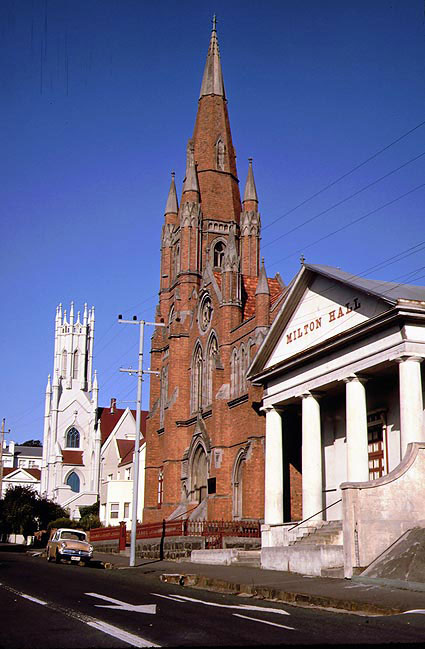
Christ Church Congregational Church and Chalmers Presbyterian Church, Launceston
[photograph by Trevor Bunning (February 1970)]
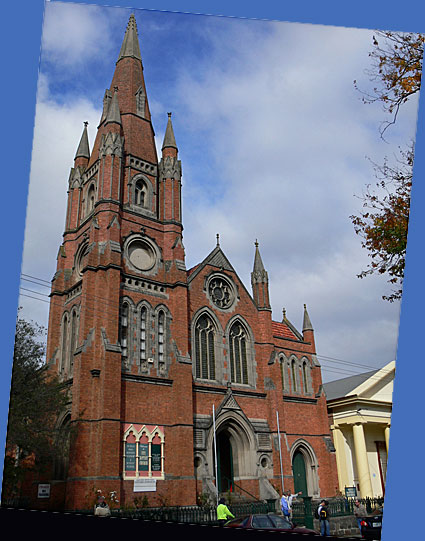
City Baptist Church, Launceston : exterior
[photograph by John Maidment (29 April 2011)]
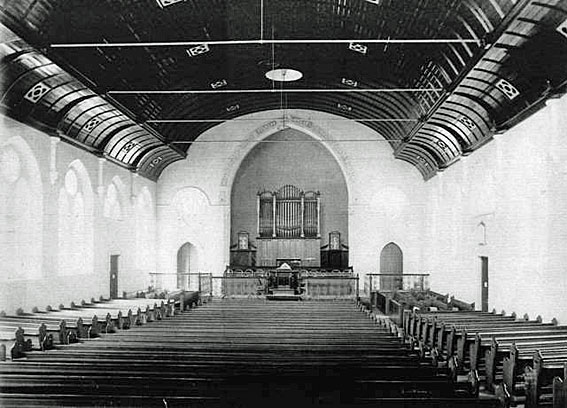
City Baptist Church, Launceston : interior before 1900
[photograph from the Architecture & Planning Library, University of Melbourne)]
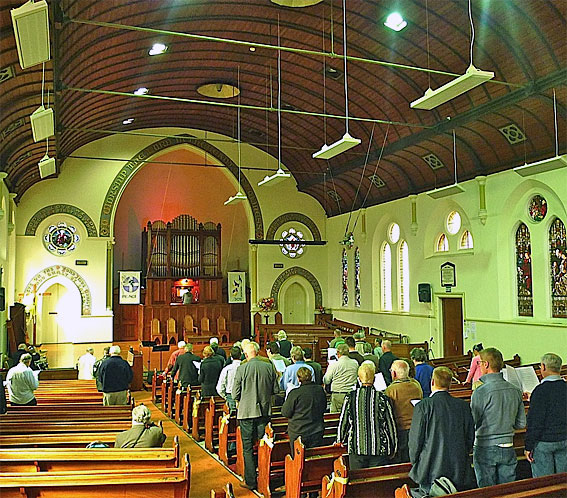
City Baptist Church, Launceston : interior
[photograph by Trevor Bunning (29 April 2011)]
Please click the Youtube link below to hear a recording of the instrument played by Michael Dudman
https://youtu.be/lcQZAneijMs?t=512
This large brick building with cement dressings in French Gothic style was designed by the Melbourne architects Grainger & D'Ebro and built in 1883-85 as Christ Church Congregational Church.1 John Harry Grainger was the father of composer Percy Grainger. The exterior is dominated by a tall tower and spire which face across Princes Square. The spacious interior, with resonant acoustics, focuses upon a large apse where the organ is located.
The first organ was located in the building next door, now known as Milton Hall. It was a single manual organ of five stops: Open Diapason, Stopt Diapason, Dulciana, Principal, Fifteenth, with an octave and a half of pedals.2 This instrument was advertised in April 1874 by S. Joscelyne and the price was quoted as £60. It remained unsold by February 1875 and its present location is unknown.3 It is likely to have been broken up.
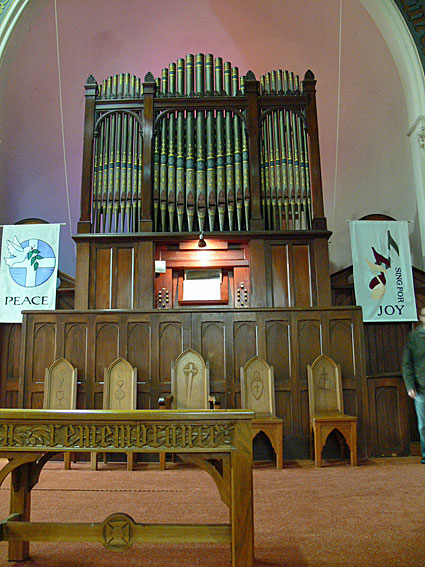
City Baptist Church, Launceston : organ
[photograph by John Maidment (29 April 2011)]
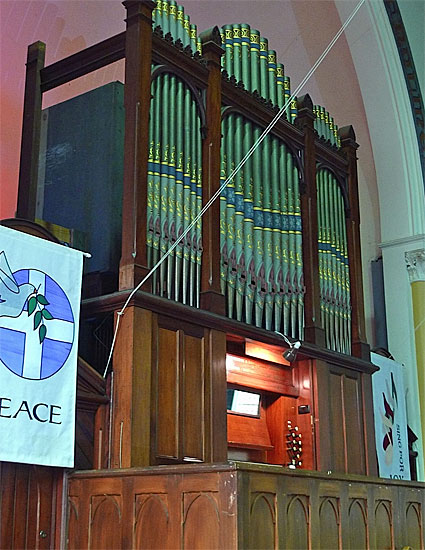
City Baptist Church, Launceston : organ
[photograph by Trevor Bunning (29 April 2011)]
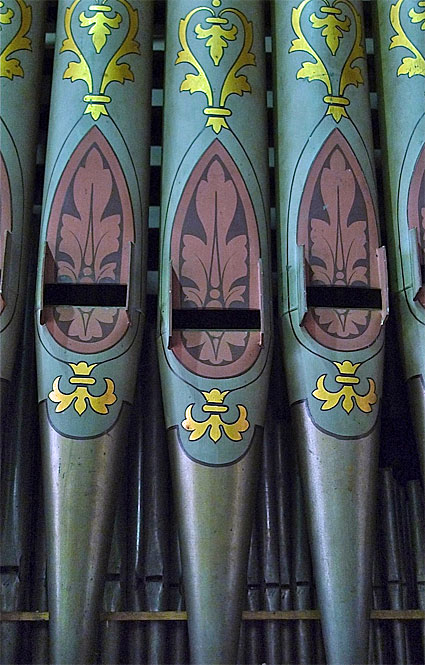
City Baptist Church, Launceston : detail of pipe stencilling
[photograph by Trevor Bunning (29 April 2011)]
The present organ was built in 1874 by Bevington & Son, Soho, London, whose nameboard above the console proudly proclaims that the firm was awarded 'prize medals Paris 1855, London 1862, Paris 1867.' The instrument was initially installed in the former church building by Messrs. Joscelyne.4 The opening recital took place on 13 April 1875, and it was reported that "The instrument had been tried previous to the opening , and found to be perfect both in tone and workmanship. It is a very handsome instrument, of the newest design, and now that it is fixed in its position proves a great ornament to the interior fittings of the church."5
It was further reported that "Valuable assistance has been rendered by Mr S. Joscelyn [sic], a member of the congregation, himself an amateur organ-builder, having turned out of hand several well-constructed instruments during the last few years, notably the organ in use at Bothwell Church, which according to testimonials from the Rev Mr Wayne the minister, Mr Wilmore the organist, and several excellent judges who have seen the instrument, has answered expectation, and given entire satisfaction. The Organ Committee at Prince's Square having determined upon having a suitable instrument manufactured at home, judiciously availed themselves of Mr Joscelyn's experience and judgment in preparing the specification, and that gentleman took occasion to inspect ten or twelve Church organs in Hobart Town and other parts of the colony, to guide him in drawing it out. The order was eventually sent, in the early part of last year, to Messrs Bevington and Son, Rose-street, Soho, London, celebrated manufacturers, who obtained first-class medals at the Paris Exhibitions, 1855 and 1867, and the International Exhibition 1862, and the organ was shipped in the Philippine, Capt. Stout, great care having been taken in stowing the packages in a snug place on board. The vessel arrived on March 18. The organ was landed in excellent order, and was erected, at the special request of the Organ Committee, by Messrs. Joscelyn. The appearance of the organ is very imposing, being 11 feet across the front, and 15 feet high, the upper part showing a number of the pipes of the open diapason, decorated in a neat and chaste style. The case is made of mahogany, which is very chaste and appropriate. …The instrument is beautifully finished in mahogany, well adapted to the Australian climate. All the stops are exquisitely voiced, and of fine tone."6
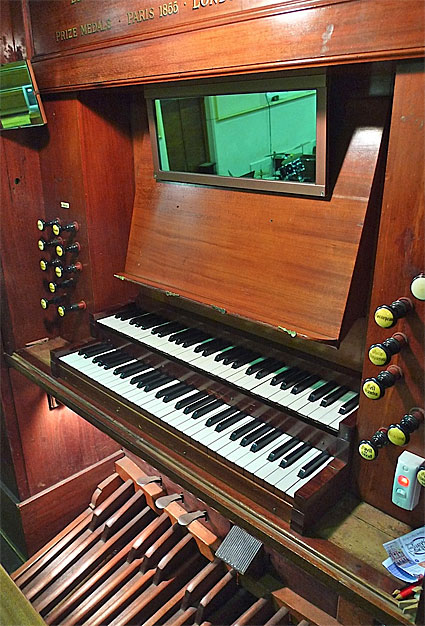
City Baptist Church, Launceston : console
[photograph by Trevor Bunning (29 April 2011)]
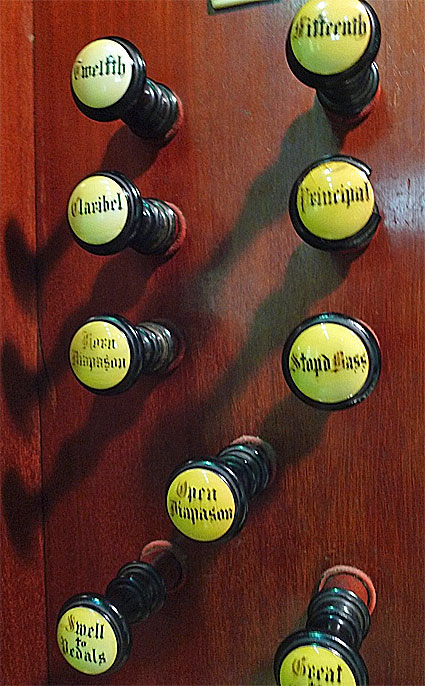
City Baptist Church, Launceston : left hand stop jamb
[photograph by Trevor Bunning (29 April 2011)]
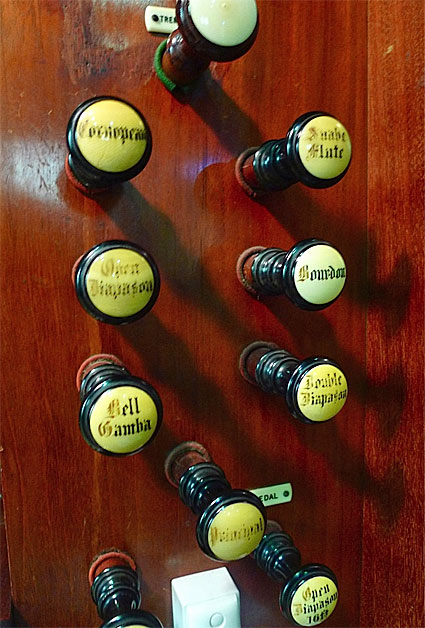
City Baptist Church, Launceston : right hand stop jamb
[photograph by Trevor Bunning (29 April 2011)]
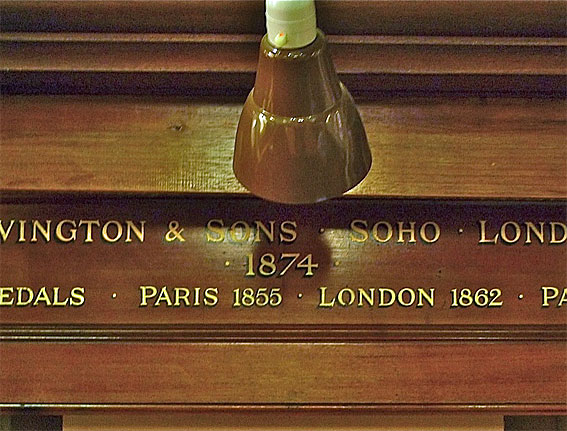
City Baptist Church, Launceston : inscription over console
[photograph by Trevor Bunning (29 April 2011)]
The organ was placed in the present building in 1885. The pedal board, pedal action and positioning of the pedal pipes were altered in 1926 by George Fincham & Sons Pty Ltd, of Richmond, Victoria who also extended the compass of the pedal Open Diapason to 30 notes.7 At some stage the double-rise reservoir was also replaced with a spring-loaded single-rise reservoir. In 1982 the organ was cleaned, and the action and pipework overhauled, by S.J. Laurie Pty Ltd, of Mordialloc, Victoria.8
Unusually, the Great drawstops are placed on the left-hand jamb and those for the Swell on the right jamb, a Bevington trait. The bass of the Swell Bourdon is placed underneath the swell box where the pipes are heavily mitred. The Swell is tuned from the rear via an elevated passage-board. The action work is superbly constructed from finely crafted timber components.
This is the finest sounding example of its builders' work in the country and an organ of enormous charm. Its small size is totally belied by its range of colour and power and is unequivocally one of Australia's most outstanding 19th century instruments speaking into a wonderful and responsive acoustic environment.
GREAT
Open Diapason
Horn Diapason
Stopd Bass
Claribel
Principal
Twelfth
Fifteenth
Swell to Great
SWELL
Bourdon
Double Diapason
Open Diapason
Bell Gamba
Principal
Suabe Flute
Cornopean
PEDAL
Open Diapason
Swell to Pedal
Great to Pedal
|
[8]
[8]
[8]
[8]
[4]
[2-2/3]
[2]
[16]
[16]
[8]
[8]
[4]
[4]
[8]
[16]
|
CC-BB
TC
CCC-BBB
CC metal
|
3 composition pedals
balanced swell pedal (not original)
mechanical action to manuals
tubular-pneumatic action to pedals
compass: 56/30 9
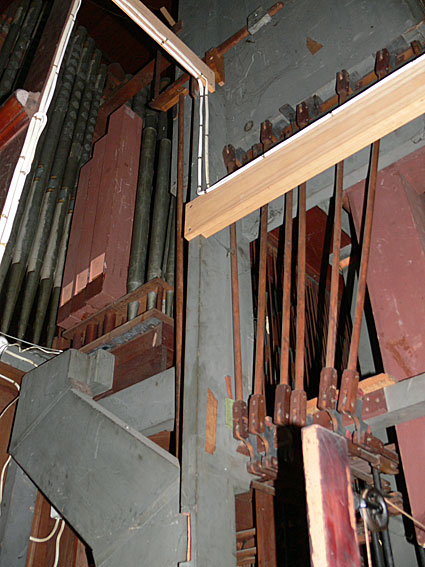
City Baptist Church, Launceston : C# side of interior showing Swell stop action,
wooden trunking and Great pipework
[photograph by John Maidment 29 April 2011)]
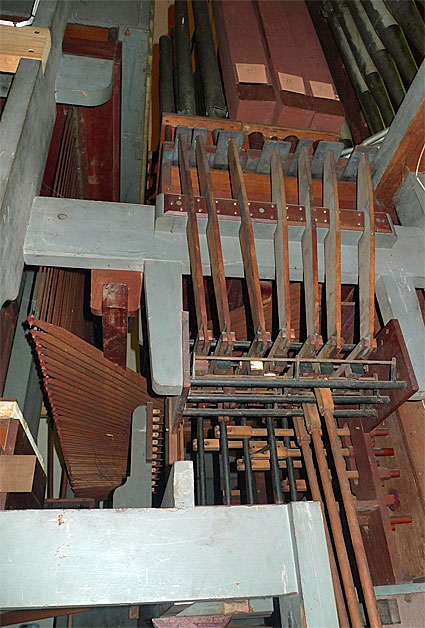
City Baptist Church, Launceston : C side of interior showing Great stop and composition pedal action,
splayed Swell backfalls, wooden trunking and Great pipework
[photograph by Trevor Bunning 29 April 2011)]
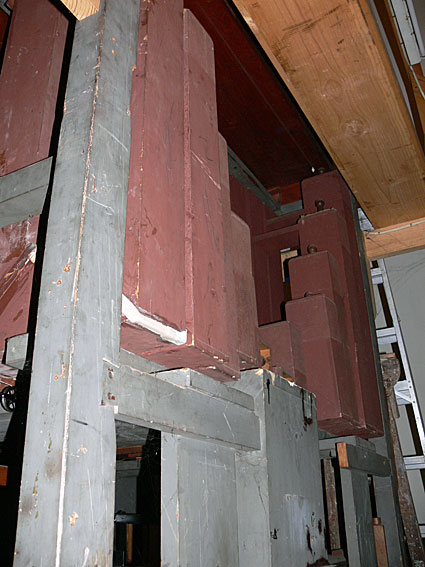
City Baptist Church, Launceston : Mitred wooden bass of Swell Bourdon beneath the Swell box
[photograph by John Maidment 29 April 2011)]
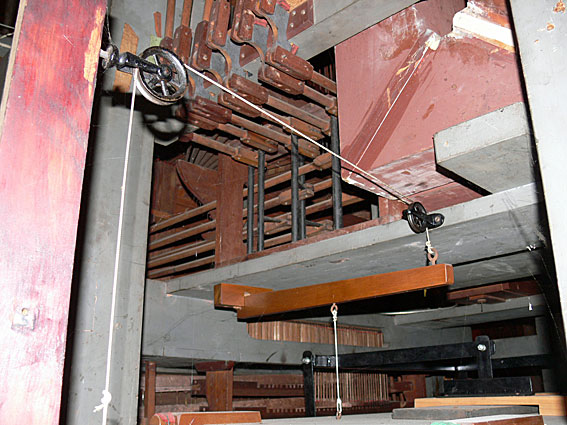
City Baptist Church, Launceston : action details
[photograph by John Maidment 29 April 2011)]
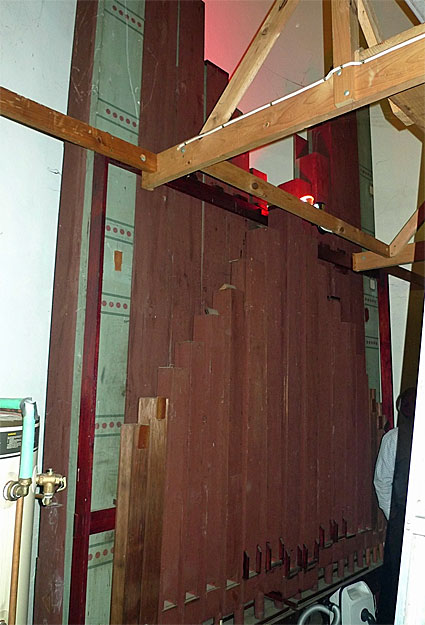
City Baptist Church, Launceston : Pedal Open Diapason placed on new chest at rear of organ –
note the stencilled CC pipe and the added unpainted pipes at the top of the compass
[photograph by Trevor Bunning 29 April 2011)]
1 The Heritage of Australia, p.7/124
2 Launceston Examiner, 4 April 1874, p.1
3 The Mercury, 27 February 1875, p.4
4 Launceston Examiner, 15 April 1875, p.2
5 The Mercury, 15 April 1875, p.2
6 Launceston Examiner, 15 April 1875, p.2
7 Brian Clark & Michael Johnson, Pipe Organs of Tasmania. 3rd ed. Hobart, Tas.: Hobart Organ Society, 2002, see under organ 25.
8 OHTA News, vol.6, no. 1 (January 1982), p.5
9 Specification noted John Maidment 1970















